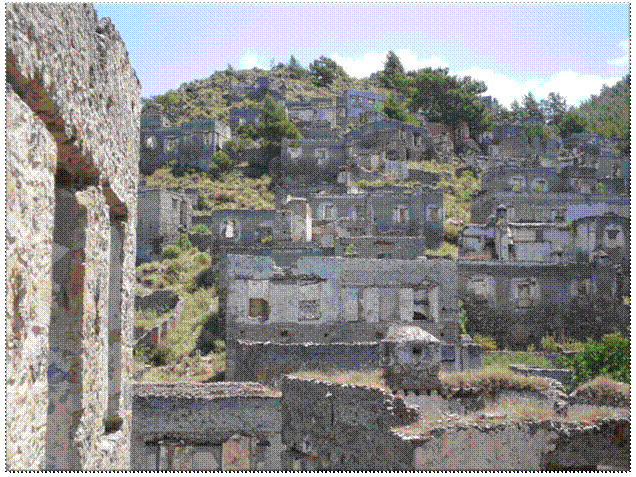Fethiye, Turkey 36 37.468N 29 05.826E

|
Kayakoy, Turkey 28th June 2011
For
those who may have read Louis de Bernieres book ‘Birds without winds’ Kayakoy is
the town on which is novel is based.
There had been a Christian settlement in this village since the
13th Century but the majority of the properties there were of a later
period.
After the departure of the Greeks the village was repopulated by Turks
returning from Greece to Turkey but the majority built homes in the valley in
front of the village where there now is a thriving agricultural community of
around 2000 with large houses and the latest
equipment. It
was a glorious day and being high the temperatures were very acceptable. We walked and clambered up what
were the old narrow streets to the highest point through remains of houses where
huge fig trees laden with ripe fruit grew at inaccessible angles, very
annoying. Anything that may
have been accessible had been consumed by goats or other animals so the thought
of picking fresh ripe figs was not an
option. Although the dolmus was full of noisy tourists just a handful got
off in the village and walked the heights the majority thinking it would be too
difficult and too strenuous preferring to sit in a bar and drink beer or an
alternative.
Sadly over the years the hillside buildings have deteriorated due
to the elements and a massive earthquake back in 1957. Timbers used on
the roofs and doors have long gone, many used by the Turks to help build new
homes however it was evident that some of these homes had been quite large and
the higher up the hill one went it was clear to see that the more affluent lived
in this area. One of
the things we were intrigued with were the different types of fireplaces which
had been lovingly built into the corners of rooms although little remained there
was just enough to appreciate that these were important status symbols.
The two remaining
churches were in good condition particularly the lower church Panagia Pirgiottis
built in the 17th C. Built with walls at least 1
m thick its murals are in fairly good condition. The pinky/orange exterior
walls glowed in the clear sunlit. There were many holes
in the inner walls, made for a reason other than joists, one was of great
interest as we could hear a group
of young fledglings making a huge racket. The hole was far too
high for us to investigate but from the rubbish on the ground below it we
thought it must be a large bird as there were dead frogs, very large beetles and
other small animals, presumable dropped by a parent bird when feeding the young.
Beside the
lower church was the old bone house – bodies were initially buried but because
of lack of space were dug up after a few years and the bones washed with wine
and then placed in the bone house.
When the Greeks finally left the island many of the bones were gathered
up and taken with them but there are still a few
On the way back from the dolmus stop we stopped off at the fish market to buy a couple of sea bass that we bbqd for supper which were delicious.
|



